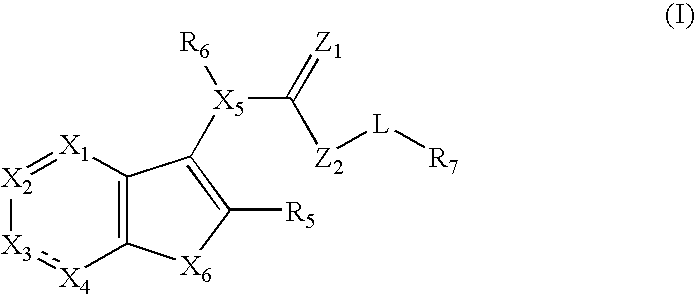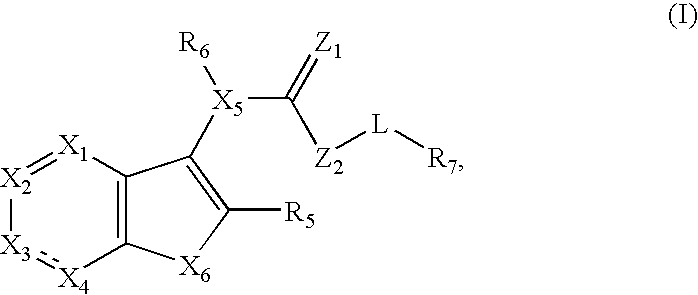Thienopyridyl compounds that inhibit vanilloid receptor subtype 1 (VR1) and uses thereof
a vanilloid receptor and thienopyridyl technology, applied in the field of compounds, can solve problems such as cell membrane depolarization, and achieve the effects of urinary incontinence and inflammation, pain relief, and bladder overactivity
- Summary
- Abstract
- Description
- Claims
- Application Information
AI Technical Summary
Benefits of technology
Problems solved by technology
Method used
Image
Examples
example 1a
(2,2-Dimethoxy-ethyl)-(5-methyl-thiophen-2-ylmethyl)-amine
[0125]Added aminoacetaldehyde dimethylacetal (27.5g, 0.261 mol) to 5-methyl-2-thiophenecarboxaldehyde (25.0g, 0.198 mol) and stirred at 0° C. for 30 min. Heated on rotavap for 30 min to remove excess aminoacetaldehyde. Obtained imine as a dark liquid (42.1g, 100%).
[0126]Dissolved imine (42.1 g, 0.198 mol) in EtOH (170 mL) and added Pd-C (10%, 6.0 g). Reaction was shaken under hydrogen (60 psi) for 40 h. Reaction mixture was filtered and the collected catalyst washed with EtOH. Concentration in vacuo afforded the amine as a red liquid (42.1 g, 99%).
[0127]MS (ESI+) m / z 216 (M+H)+; (ESI−) m / z 214 (M−H)+; 1H NMR (DMSO-d6) δ 2.38 (s, 3H), 2.68 (d, J 5.4, 1H), 3.25 (s, 6H), 3.79 (s, 2H), 4.64 (t, J 5.4, 2H), 6.60 (m, 1H), 6.70 (d, J 3.0, 1H.
example 1b
N-(2,2-Dimethoxy-ethyl)-4-methyl-N-(5-methyl-thiophen-2-ylmethyl)-benzene sulfonamide
[0128]Crude (2,2-dimethyloxy-ethyl)-(5-methyl-thiophen-2-ylmethyl)-amine (1) (43.41 g ˜75% pure, 0.15 mol) was dissolved in EtOAc (150 mL) resulting in a yellow solution. Triethylamine (22 mL, 0.16 mol) was added. The mixture was cooled to 0° C. in ice bath. p-Toluenesulfonyl chloride (29.68 g, 0.16 mol) was added in small portions keeping the temperature below 15° C. After addition was complete the mixture was left in ice bath and allowed to slowly warm to room temperature and stirred for 20 hrs. The milky-yellow mixture was diluted with EtOAc (300 mL) and washed with water (2×400 mL), 1 M HCl (2×400 mL), water (1×400 mL), sat NaHCO3 (1×400 mL), and brine (1×400 mL), dried (MgSO4) and condensed to provide the title compound as a reddish-yellow liquid, 50.56 g. Product was not purified.
example 1c
2-Methyl-thieno[2,3-c]pyridine
[0129]2-Methyl-thieno[2,3-c]pyridine (3): 76059-85: N-(2,2-Dimethoxy-ethyl)4-methyl-N-(5-methyl-thiophen-2-ylmethyl)-benzenesulfonamide (2) (50.56 g crude) was dissolved in dioxane (250 mL) and conc. HCl (200 mL) was added cautiously. The dark red solution was heated at gentle reflux (105 to 110° C.) for 24 hours. The volume was reduced by approximately half, then diluted with ether (200 mL). The pH was adjusted to between 7 and 8 using 50% NaOH / H2O and sat NaHCO3 solution with cooling. More ether (400 mL) was added, the mixture was filtered to remove insoluble material and the phases separated. The organic phase was washed with water (2×350 mL), dried (MgSO4) and condensed to dark red-brown oil. Purification was accomplished using Kugelrohr distillation (120 to 130° C.) to give 11.89 g of title compound as a pale yellow liquid.
[0130]MS (ESI+) m / z 150 (M+H)+; (ESI−) m / z 148 (M−H)+; 1H NMR (DMSO-d6) δ 2.64 (s, 3H), 7.23 (s, 1H), 7.69 (d, J 6.4, 1H), 8.40...
PUM
| Property | Measurement | Unit |
|---|---|---|
| temperature | aaaaa | aaaaa |
| temperature | aaaaa | aaaaa |
| final volume | aaaaa | aaaaa |
Abstract
Description
Claims
Application Information
 Login to View More
Login to View More - R&D Engineer
- R&D Manager
- IP Professional
- Industry Leading Data Capabilities
- Powerful AI technology
- Patent DNA Extraction
Browse by: Latest US Patents, China's latest patents, Technical Efficacy Thesaurus, Application Domain, Technology Topic, Popular Technical Reports.
© 2024 PatSnap. All rights reserved.Legal|Privacy policy|Modern Slavery Act Transparency Statement|Sitemap|About US| Contact US: help@patsnap.com










